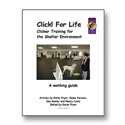Originally published on 10/5/17.
Editor's note: Dogs are relinquished to shelters for many reasons. People move, have a new baby, get divorced, lose their homes. Sometimes they relinquish their dogs because of health and behavior issues. But one thing is certain: most dogs that come into a shelter are not prepared for the shelter environment. They are almost always seriously stressed and likely to exhibit behavior problems. And, dogs that are stressed or have behavior problems are often viewed as less adoptable and remain at shelters longer.
How can a shelter use limited time, money, and resources to help these dogs get a second chance? How can shelters teach behaviors that help these dogs find and stay in new homes, behaviors that help dogs learn to trust people again? What can shelter staff members do to alleviate stress and make life better for the dogs while they are waiting for their forever homes? Karen Pryor Academy's course, Shelter Training & Enrichment, is designed to help shelter staff, volunteers, managers, or trainers reduce the stress and enrich the lives of animals living in a shelter. In this interview, Karen Pryor explains how.
What was the impetus to create the Shelter Training & Enrichment course?

We've always wanted to help dogs in shelters. Anybody trainer, really any person, who enters a shelter wants to help. Dogs don't always arrive at a shelter in the best shape behaviorally, and they need all the help that they can get. It is easy to see that there's so much that could be done—without even taking the animals out of the kennels. Often there is no place for shelter managers and staff to learn techniques that could help. Shelters can rarely afford to hire expensive behaviorists and trainers.
This course was proposed by an inventive shelter manager, Leanne Falkingham, and KPA faculty member Steve Benjamin. With Steve's knowledge of training and Leanne's knowledge of shelters, they created a course that any shelter can benefit from, without any previous knowledge. This course is based on their experiences, and ours, presenting what we know about enriching animals' lives in a way that fits with the challenges of the shelter environment: too many dogs, not enough time, no budget. The course contains a wealth of ideas on training behaviors that will help make shelter animals more appealing to adopters, reduce their stress, and improve their quality of life.
Giving a shelter money is good; the shelter can buy blankets and food. But how about buying them a lifetime's worth of making dogs more adoptable? And how about giving the dogs the skills they need to live with their families, so that they don't get brought back to the shelter? That's what we want to do for the shelters. It's that simple.
Who is the course designed for?
Anybody can go through the Shelter Training & Enrichment course. Whether you are a shelter volunteer, staff member, or administrator, the course is designed to make it easy to pick up what you need from it. And it is so cleverly designed that it works without you having to have a teacher—although course instructors Leanne and Steve are there to answer questions if they come up. The shelter course is designed to be fun to complete, and to give you quick results in problem-solving. It teaches you how to have quiet kennels, teach loose-leash walking, encourage shy cats to greet visitors, and have dogs sit at the door or back up when the kennel door opens instead of bolting. What is provided here is going to change a shelter's culture. The shelter course offers a shelter the chance to do something with the resources it has, to have successes, and to see change that benefits the entire shelter immediately.
It's like the proverb "Give a man a fish and he eats for a day. Teach him to fish and he eats for a lifetime." This course is a clicker course, and it's full of little things that make a difference in that way. You'll be able to do all the clicker training you need in the shelter. It's that simple. The course is broken down into smaller elements, with step-by-step exercises you can do with shelter animals. There are also training videos to watch. Throughout the course you experience many successes along the way, and you learn without even realizing how much you've learned.
In what ways does the course improve the lives of shelter dogs?

Enrichment in a shelter
Most shelter dogs have very little experience with the outside world—or they have had a lot of bad experiences. They are frightened. They don't know their own names. They are not housebroken. They are not well-trained, and they don't necessarily feel well. They are just reacting to everything that goes on around them. What these dogs have not yet learned is that they can make things happen for themselves. With the littlest clicker experience, they learn that they can be paid to stop barking. This changes that dog's outlook on the world. Instead of…
"Here comes a stranger. I'm frightened. I'm going to bark. I'm going to jump. I'm going to bolt."
…he thinks,
"Here comes a stranger. Maybe he's got a clicker. I'm going to sit. I'm going to smile. I'm going to be good."
And then they become interested in people, instead of just their own excitement. You can't do that with just treats alone. It's realizing that they made you click that makes dogs start thinking about what they are doing. They just need to have the world make a little more sense to them. Then they can start to think about how to fit into a household.
For instance, I love the section of the course that focuses on enrichment. One of the problems, especially with young, adolescent dogs, is that they are bored and they are restless. And that can lead to trouble. So you need games and things for them to do. What are they going to do in a little steel pen? The shelter manager and the shelter trainer who designed this course have put together all kinds of enrichment ideas for dog toys that cost no money, like hiding treats in an egg carton and making a treat puzzle out of a cereal box. Just working with a puzzle or a little game like that gives dogs enough mental refreshment that they are better able to tolerate the strangeness and the boredom of the confinement. During that period, before they are adopted, it is a kindness to the dogs to give them something to think about, something to do.
What are some of the things a shelter can do to see change immediately?

Clicking for quiet
The first thing you want to do is reduce the stress levels for everybody, and barking is the single most stressful thing. That incessant barking, sometimes one hundred dogs barking, is exhausting for all the people and for all the dogs. Not to mention the cats; they really suffer. They all suffer. I've seen visitors come through the door, hear the constant barking, and walk right out the door again. I've seen shelters where they hand out earplugs to the visitors—and to staff, too. So the first thing that I like to see a shelter do, and this is demonstrated in the course, is have quiet kennels. And you can, with clicker training. I remember visiting one shelter that had converted to clicker training. The kennel was so quiet. When I remarked about this to a staff member, she said. "Oh yes, it has always been this way." Well I know that when I had visited four years earlier, it wasn't quiet. So I asked, "Didn't you have earplugs?" "Oh yeah," she replied. "There was a bowl of earplugs."
One of the largest kennels I visited had 300 dogs. While I was there, a car pulled into the driveway. The whole shelter went crazy. All those dogs barking. "Oh, a car! A car!" And they barked like that day after day, month after month, year after year. I grabbed a bunch of volunteers and gave everyone a paper cup with a little kibble for the dogs. We went out and de-barked the kennel with just click and treat! We walked back and forth and every dog that wasn't barking got a click and a kibble from someone. The click is crucial. To the dog, the kibble only means "I got food." The click tells him "Oh, I did something. I made that happen."
We got all of those dogs quiet. They were not barking anymore. We could stop it—just like that! Isn't that something? It's hard for people to believe. I've seen it in Dallas, at a great big shelter with hundreds of dogs. A quiet shelter, with 2-3 dogs in a pen. When strangers walk through the kennel, all the dogs are sitting in pleasant groups looking at the people. They are happy, less stressed, and ready to be adopted. And the visitors can tell.
We've talked a lot about how the course can help shelter dogs, but what about the cats?
It's very much the same with the cats. A lot of older cats have owners who died or went into a nursing home. Those cats have never been out of their houses. They don't know anything about strangers or other cats, and are now surrounded by dozens of them. Those cats come in completely unequipped to handle the shelter environment, and they are terrified. You may not see cats pacing in their cages, the way the dogs do, and the cats don't meow constantly. But they can be frightened and they can be depressed. A cat that is sitting in the back of the cage and won't come forward is a cat that is suffering. It doesn't show it, but it is. It's frantic and scared and miserable. Those cats just shut off. Those cats never get adopted. It's the ones that come to the front and interact with you that get new homes. With the littlest clicker and intervention, you can get the miserable cats out of the corner. One of the ways to do this is by training a cat to touch a target stick with a nose or a paw. Hold it up and the cat is going to touch it. Then, you click and give a little piece of tuna fish. The cat figures out in about four clicks how to get you to give him tuna fish. Suddenly, you have a cat that is training you to deliver tuna fish, following the target stick, and jumping up and reaching the stick with its paw. That cat is now an adoptable cat, because every human who comes by looks like a potential clicker person to the cat.
In another shelter that I visited, children were teaching the cats to jump over other cats on tables. These were 12-to-14-year-olds doing the training. Cats on the table with the kids! These cats were re-homed with clickers and the shelter's adoption rate tripled—and those cats never came back. This is the type of success that doesn't catch on from shelter to shelter because shelters don't talk to each other; they don't have a joint organization. That is why a course like KPA's Shelter Training & Enrichment course is so important.
What about the cats that have already been in the shelter a long time?

Cat targeting a stick
Many cats that have been in shelters for a long time get put to sleep because they won't socialize or associate. But it's not that they can't. For example, I visited one shelter that had a wall of cats, 3 or 4 cats high. A lot of cats! One of the volunteers, a retired surgeon, was visiting the cats when he stopped and looked at cat at the end of a row, crouched way in the back of her cage. A staff member noticed the volunteer looking at the cat and said, "Oh, don't bother with that one. She is a hisser." Sure enough, when he bent down the cat went "Hsssss!" The volunteer began to click and toss food in her cage anyway. He clicked and threw food all the way to the cat at the back of the cage, and the cat ate the food. He paused and the cat took a paw and stepped forward. He clicked the movement, and gave her more food. And then she took another step forward, so he clicked her again. In about 10 clicks, this cat was up on her feet and moving toward the front of the cage. He really had her coming, and then she made eye contact. In no time, she was rubbing herself on the bars and purring.
The cat had been in that shelter six months. For six months she hissed whenever anybody looked at her. She had just given up. She thought, "This is a terrible place and this is what I'm going to do here." She only ate at night, and wouldn't go to the bathroom when anyone was around. For six months she had been like that. Yet once she figured out that she could control her circumstances, she was fine. The staff was amazed.
You just have to unlock their doors, mentally. I think that's really important for cats. The click works really well for any cat. "I can make them do that. I get tuna fish. I've got this."
What does the course mean to you personally?
I think it's one of the things that we've done that works. We've always been committed to helping shelters. But with this course, we are now at the level where we can actually help more than one person, more than one dog at a time. We can make a difference for an entire organization. ClickerExpo was our first big effort to make a difference on a large scale. But shelters don't have a place to go. Our courses give people a place to go. I love having courses that people can take without any previous training. Just like our Puppy Start Right course, the Shelter Training & Enrichment course is a "no training experience required" opportunity. I am so pleased with how wonderful the Shelter Training & Enrichment course turned out to be, how well-done it is. It's beautiful.







Post new comment